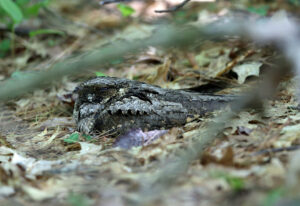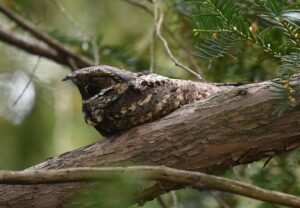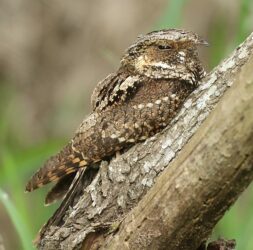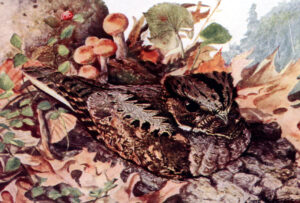By volunteer
 By Volunteer Naturalist, Bill Napper
By Volunteer Naturalist, Bill Napper
On warm spring and summer nights, as we venture into the depths of Bernheim Forest on one of our Creatures of The Night programs, the air comes alive with the hypnotic, repeating song of the Eastern Whippoorwill (Antrostomus vociferus.) As night falls and the last sunlight fades, other birds slowly grow silent, surrendering the stage to the nocturnal virtuoso. The whippoorwill begins to sing its name – whip-poor-will, whip-poor-will, whip-poor-will. Each melodious note cascades through the foliage, weaving an enchanting tapestry of sound that surrounds you. In the hush of twilight, the whippoorwill’s song becomes the soundtrack of the night.
For centuries, our ancestors have been captivated by this mesmerizing refrain, as it echoed through the ages and became ingrained in folklore. Their enduring connection to this nocturnal serenade has been passed down through generations, allowing us to experience a shared moment of solace and wonder across time.

The legend of the lonely whippoorwill emerged from the belief that the male endlessly echoed its mournful melody in the absence of its dearly missed partner. People reasoned, could there be any other reason for the bird’s relentless serenade, if not for the gaping void left by the unreturned affection of its beloved?
Although the tale of the lonely whippoorwill is emotionally stirring, it is ultimately a fictional narrative. In reality, female whippoorwills are indeed nearby, attentively listening to the males’ repeated song. Ultimately, they will select a mate who demonstrates his strength and vigor, which they assess by the number of times he is able to continuously repeat his song.
The whippoorwill’s genus name “vociferus” comes from Latin, where “vocifer” means to shout or cry out and very accurately describes its distinct and loud song that can carry over long distances.
The Whippoorwill’s Life Under the Moon
Henry David Thoreau once wrote, “The note of the whip-poor-will echoing across the fields is the voice that the moon and moonlight use to woo me.” The Miami (Myaamia) Native American tribe, originally located in Indiana and southern Michigan, called the full moon in their fourth lunar month of the year the “Whip-poor-will Moon” or “Wiihkoowia Kiilhswa.” Studies reveal the lives of whippoorwills are closely tied to the moon. They sing and hunt more actively on nights with moonlight, and they closely monitor the moon’s phases in order to time their mating with astronomical precision. This impeccable timing allows the devoted parents to harness the moon’s radiant glow, so they can effectively hunt the nutritious insects they need to feed their young, ultimately giving them a better chance at survival.
The Whippoorwill’s Nighttime Nabs
 Whippoorwills have a distinctive hunting technique that sets them apart from most birds. Rather than searching for prey from above, these birds prefer to position themselves beneath their targets. From down below, they spot their prey —usually moths—silhouetted against the moonlit sky, and then, in a scene reminiscent of “JAWS”, they surge upward, their enormous mouths gaping wide, snatching their prey from below like the fearsome shark of the deep.
Whippoorwills have a distinctive hunting technique that sets them apart from most birds. Rather than searching for prey from above, these birds prefer to position themselves beneath their targets. From down below, they spot their prey —usually moths—silhouetted against the moonlit sky, and then, in a scene reminiscent of “JAWS”, they surge upward, their enormous mouths gaping wide, snatching their prey from below like the fearsome shark of the deep.
Upon seeing the unexpectedly cavernous mouth of the whippoorwill, a person might experience a moment of sheer surprise and disbelief. Accustomed to the appearance of more familiar birds, one would be taken aback by its vastness relative to its body size. No doubt this is why its genus, Antrostomus (Ann-trost-uh-mus), has origins in Ancient Greek, combining the terms “antron,” which means “cavern,” and “stoma,” meaning “mouth.” Another surprising feature of the mouth is that its tongue is vestigial, meaning it probably has little or no tasting function.
Whippoorwill Folklore & Falsehoods
The bird’s peculiar mouth has inspired creative explanations, leading to its nickname “Goatsucker.” The source for the origin of this nickname is tricky, but as far back 2000 years ago, Aristotle, acquainted with the European nightjar, a whippoorwill relative, wrote, “flying to the udders of she-goats, it sucked them dry.” Goat milk was a vital staple back then, and milk stealing accusations served to tarnish the bird’s reputation. The lasting impact of this superstition is evident in the scientific classification of whippoorwills, nighthawks, and other nightjars, which belong to the order Caprimulgiformes (kuh-prih-muhl-juh-form-eez), a Latin term for “goat-milker.”
European settlers in the Americas brought the “goat-milker” myth with them and gave the bird other nicknames, such as “dew-hawk,” “fern owl,” and “lich fowl.” The name “fern owl” is appropriate because Whip-poor-wills nest on the ground, where ferns commonly grow, and have feathers resembling owl plumage. The name “dew-hawk” probably originated due to their nighttime activity when dew forms. On the other hand, the term “lich fowl,” meaning “corpse bird,” likely reflects people’s fear of the night rather than the bird’s actual characteristics. It’s unfortunate that humans often associate negative or frightening connotations with nighttime and nocturnal animals.
I choose not to perpetuate the many negatively oriented, unwarranted myths surrounding whippoorwills, but to highlight how people often associate night and nocturnal creatures with negative experiences, I will mention a fictitious story published in the August 9th, 1941 issue of The New Yorker. Titled “The Whippoorwill”, by James Thurber, it tells of a man named Mr. Kinstrey driven mad by the constant singing of a whippoorwill, causing him to lose sleep and eventually leading him to kill everyone in his house, including himself.
The Elusive Whippoorwill – Often Heard, Seldom Seen

Due to various factors, these birds are rarely seen in their natural habitat. This may be for the best, given their unusual gaping mouth and people’s less-than-flattering perception of these birds, as folklore has shown. To begin with, they are nocturnal, which already separates them from our daily lives. Also, each male bird requires a large mating territory of approximately 25 acres, making them widely dispersed. Additionally, they have cryptic plumage that blends seamlessly with their surroundings, making them nearly impossible to spot, even if you were mere inches from them. As a result, most people have never seen a whippoorwill. Even if you have, it can be challenging to describe the bird verbally. About the best description you can give is to say, “Imagine if an owl and a bullfrog had a baby and gave it feathers that look like tree bark.”
If you think whippoorwills are elusive, then its close relative, the “Chuck-will’s-widow”, also found in Bernheim, would seem almost mythological. To date, I’ve only heard the “Chuck-will’s-widow” in a single location within Bernheim’s boundaries.
The Whip-poor-will’s Summer in Bernheim
In April, whippoorwills arrive in Bernheim after migrating from Mexico and Central America. The males immediately begin their musical marathons to establish their territory and attract mates. As mentioned, the repetition of their song is crucial to impress the females. Any disruptions like rain, wind, and human-made noise pollution can affect their performance. Sadly, I have personally witnessed how planes flying overhead at night can disturb the male’s singing.
As the sun rises, the whippoorwill becomes silent, blending into its surroundings by mimicking the tree branch it perches on. Unlike other birds that perch upright and perpendicular on a branch, the whippoorwill lies flat and parallel, camouflaged by its cryptic plumage. They spend their days resting and quietly observing the bustling diurnal world.
After a few weeks, each female will choose a strong and healthy mate, and the couple will remain monogamous for the season. Timed with the lunar cycle, the female will lay up to two cream-colored eggs, marbled with lavender-gray and yellowish-brown, directly on the forest floor (not in a formed nest that might get noticed.) Both parents will incubate the eggs, then in about 19-21 days, well-developed, downy-covered, adorable chicks will hatch about a week before the full moon.
Both parents will feed their babies by vigorously hunting insects during the moonlit Bernheim nights. The babies develop quickly and become more independent each day, soon able to avoid predators without parental care. The female may start a second brood nearby when the first brood is only 7 to 9 days old. Some have observed that young whippoorwills have been known to accept food from their parents at 30 days of age, indicating the parents’ continued close watch and care over their offspring.
As the summer draws to a close in Bernheim, and after a successful season spent thriving in the abundant and sheltered surroundings, mornings with crisp autumn air signal a change is coming. The family sets their sights southward, anticipating their migration back to Mexico and Central America for the winter.
The Fragile Future of Whippoorwills
 Unfortunately, whippoorwills, like many bird species, face numerous environmental challenges that threaten the population. The primary issues are the loss of their preferred forest type (dry, deciduous, having little to no underbrush, close to open areas – a forest type Bernheim fervently protects), declines in food sources due to pollution and pesticide use, light and noise pollution, and car collisions. As a result of these and other causes, the whippoorwill population has declined by nearly 70% in recent decades.
Unfortunately, whippoorwills, like many bird species, face numerous environmental challenges that threaten the population. The primary issues are the loss of their preferred forest type (dry, deciduous, having little to no underbrush, close to open areas – a forest type Bernheim fervently protects), declines in food sources due to pollution and pesticide use, light and noise pollution, and car collisions. As a result of these and other causes, the whippoorwill population has declined by nearly 70% in recent decades.
A recent study using GPS tags attached to the birds revealed a new alarming finding – nearly all whippoorwills migrate at the same time, passing through east Texas in early October. This suggests that a single environmental disaster in that area could potentially devastate their numbers.
The whippoorwill has been a source of inspiration for countless renowned musicians, authors, and poets, and you too can find your own inspiration by joining us on one of our Creatures of the Night programs this spring or summer. Come experience the magic of the moonlit whippoorwill echoes in their natural habitat for yourself. Sign up now to explore and experience the extraordinary!

